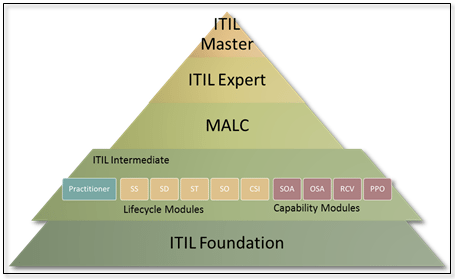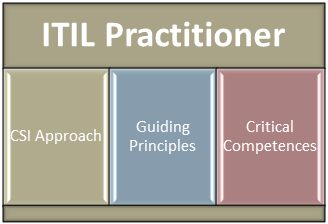 Branimir Valentic
Branimir Valentic
August 30, 2016
ITIL implementation is usually pretty challenging. Hundreds of pages explain processes you want to implement (and need to explore), their application in the live environment and struggles with people, processes, and services once you implement them. Then you try to simplify it with training. That’s, basically, a great idea. But, the foundation level (see Figure 1) will give you a rough overview and the intermediate level is time (and money) consuming.
Axelos (owner of ITIL) figured that out and made a step towards practical application of ITIL – ITIL Practitioner Guidance. It’s a new publication and a new option for training. The base is continual improvement, but it encompasses the whole IT service lifecycle. Let’s see some more details.
ITIL Guidance (the set of five core books) is basically – the ITIL. Divided into five stages (Service Strategy, Service Design, Service Transition, Service Operation, and Continual Service Improvement), this is the framework that covers the complete lifecycle of the IT services. Every lifecycle stage contains certain processes (and functions, in the case of Service Operation) with detailed description, workflow, etc. (e.g., Incident Management – read the process description inside the Service Operation book and implement it inside your own organization depending on your situation, people, know-how, tool, etc.).
Additionally, this is a new certification, i.e., training in the ITIL certification scheme (see Figure 1). It belongs to the intermediate level and can be combined with any other intermediate certification, if you are collecting training credits on the path towards ITIL Expert. I also found that this certification is liked by people who are not willing to go all the way to the Expert certification.

Read the articles “ITIL Certification” and “ITIL Certification Path – list of all available ITIL trainings, exams and certificate” to learn more about ITIL certification.
First of all (from my point of view), ITIL Practitioner Guidance is a pleasant read. Yes, there are paragraphs where you will have to stop and think about the text you just read, but that’s because the picture that you are looking at is much wider. This means that some other parts of the ITIL service lifecycle are related and you have to “revise” your thoughts and connect facts coming from several processes. See this as a positive effect – finally, you can relate processes and activities throughout the service lifecycle. And, you can find a lot of templates, related to those activities, which you can use.
So, here we don’t have the usual guide (or, sometimes called “a cookbook”) for processes and functions. Let’s see what the content of the guidance is. Figure 2 shows a high-level overview of the Practitioner Guidance, comprised of:
The last section of the Guidance is – a toolkit. This is one of the most attractive parts of the guide. This toolkit contains more than 25 templates, as well as link towards “non-ITIL” frameworks implementation (e.g., Agile, Lean, DevOps … etc.). Templates are explained in the text (depending on the context, i.e., where to apply them) and described (more details about the content) in the appendix. So, there are no excuses not to use them.

This depends on what you want to achieve. Meaning, the toolkit that you will find inside the ITIL Practitioner Guidance will help you manage your services in different stages throughout the service lifecycle (i.e., get a better understanding of how to implement ITIL in real-life situations); it could also be your practical guidance while implementing processes inside your organization. On the other side, there are a lot of ITSM professionals who have chosen ITIL as their career development path. If you are one of them (or considering becoming one) – great. Now you have one more option.
Namely, ITIL Practitioner is different from other Intermediate qualifications (or, at least, it should be). Once you finish your ITIL Foundation qualification you should have a basic understanding of ITIL. Intermediate qualifications (both capability as well as lifecycle modules) cover only certain areas of ITIL. Practitioner is one of the possible qualifications on your ITSM path towards Expert certification and covers a practical approach to the ITIL implementation in various stages of the service lifecycle (no process descriptions, but rather many practical examples of ITIL implementation).
So, no matter if you are looking for one more option of your ITSM career development or for a more practical approach to the ITIL framework, ITIL Practitioner Guidance will surprise you in many aspects where you will recognize yourself and issues you are fighting with. And, while I was reading the guide, quite often I got that magical moment – “Ah, now I know…” (how).
Use this free ITIL Gap Analysis Tool to check your compliance with ITIL requirements.